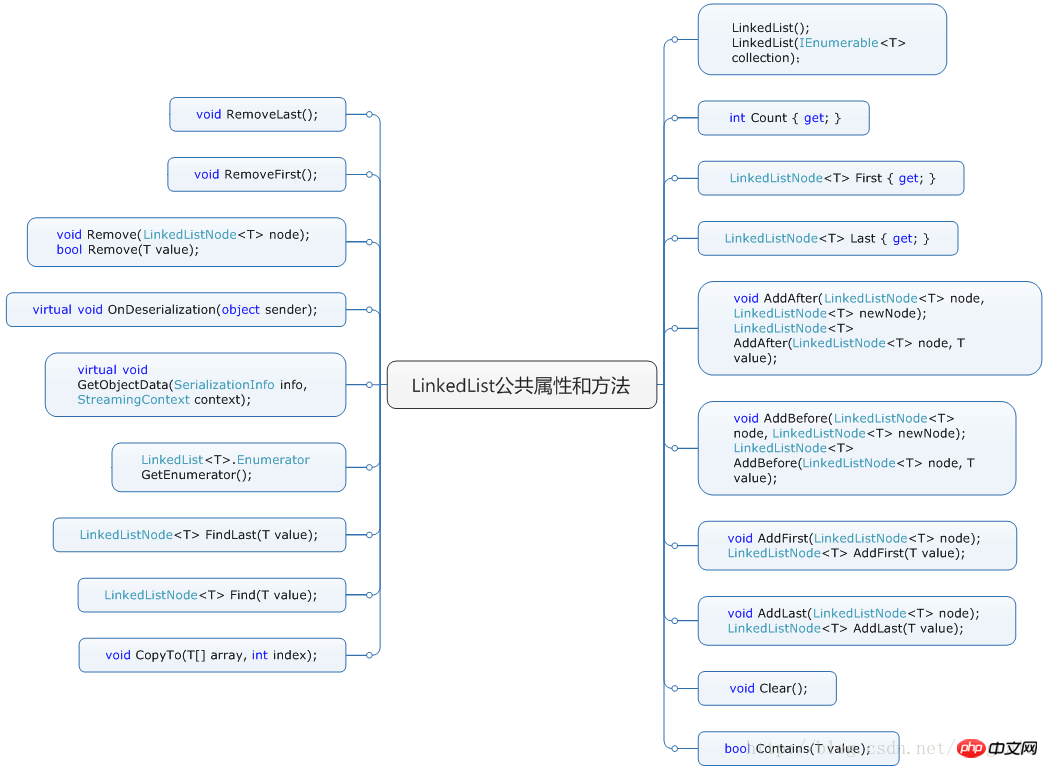.NET框架中的LinkList,实现的是双向链表,总结下它的实现源码。
先看下LinkedList提供的公有属性和方法的导图:

1 LinkedList实现的接口:
public class LinkedList<T> : ICollection<T>, ICollection, IReadOnlyCollection<T>, ISerializable, IDeserializationCallback
2 LinkedList的全局变量包括,
head是封装的类内头节点;
// This LinkedList is a doubly-Linked circular list.
internal LinkedListNode<T> head;
internal int count;
internal int version;
private object _syncRoot;
//A temporary variable which we need during deserialization.
private SerializationInfo _siInfo;
// names for serialization
private const string VersionName = "Version";
private const string CountName = "Count";
private const string ValuesName = "Data";封装的每个节点的数据结构为:
public sealed class LinkedListNode<T>
{ public LinkedListNode(T value);
//获取LinkedListNode所属的LinkedList
public LinkedList<T> List { get; }
public LinkedListNode<T> Next { get; }
public LinkedListNode<T> Previous { get; }
//获取节点中包含的值。
public T Value { get; set; }
}3 构造函数:
public LinkedList() //默认的构造函数
{
} //带有参数的
public LinkedList(IEnumerable<T> collection)
{ if (collection == null)
{ throw new ArgumentNullException(nameof(collection));
} foreach (T item in collection)
{
AddLast(item);
}
}在构造IEnumerable类型的collection时,用到了AddLast(T)方法,它还有一个重载,工作细节如下:
public LinkedListNode<T> AddLast(T value)
{
LinkedListNode<T> result = new LinkedListNode<T>(this, value);
if (head == null)
{
InternalInsertNodeToEmptyList(result);
} else
{
InternalInsertNodeBefore(head, result);
} return result;
}
public void AddLast(LinkedListNode<T> node)
{
ValidateNewNode(node);
if (head == null)
{
InternalInsertNodeToEmptyList(node);
} else
{
InternalInsertNodeBefore(head, node);
}
node.list = this; //结合LinkedListNode看
}以上2个方法,语义是插入某个节点,
分插入新节点到空list中,InternalInsertNodeToEmptyList
插入新节点到不为空的list中,InternalInsertNodeBefore,并且给出在哪个节点前插入newNode,还判断了新插入的节点是不是一个有效的新节点。
internal void ValidateNewNode(LinkedListNode<T> node)
{ if (node == null)
{ throw new ArgumentNullException(nameof(node));
} if (node.list != null)
{ throw new InvalidOperationException(SR.LinkedListNodeIsAttached);
}
}同时,还给出判断一个节点是不是有效节点:
internal void ValidateNode(LinkedListNode<T> node)
{ if (node == null)
{ throw new ArgumentNullException(nameof(node));
} if (node.list != this)
{ throw new InvalidOperationException(SR.ExternalLinkedListNode);
}
}这是双向链表比较重要的内部方法,
InternalInsertNodeToEmptyList的实现细节:
private void InternalInsertNodeToEmptyList(LinkedListNode<T> newNode)
{
Debug.Assert(head == null && count == 0, "LinkedList must be empty when this method is called!");
newNode.next = newNode;
newNode.prev = newNode;
head = newNode;
version++;
count++;
}InternalInsertNodeBefore的实现细节:
private void InternalInsertNodeBefore(LinkedListNode<T> node, LinkedListNode<T> newNode)
{
newNode.next = node;
newNode.prev = node.prev;
node.prev.next = newNode;
node.prev = newNode;
version++;
count++;
}4 链表自然离不开插入某个节点的公有方法,
public LinkedListNode<T> AddAfter(LinkedListNode<T> node, T value)
{
ValidateNode(node);
LinkedListNode<T> result = new LinkedListNode<T>(node.list, value);
InternalInsertNodeBefore(node.next, result); return result;
} public void AddAfter(LinkedListNode<T> node, LinkedListNode<T> newNode)
{
ValidateNode(node);
ValidateNewNode(newNode);
InternalInsertNodeBefore(node.next, newNode);
newNode.list = this;
} public LinkedListNode<T> AddBefore(LinkedListNode<T> node, T value)
{
ValidateNode(node);
LinkedListNode<T> result = new LinkedListNode<T>(node.list, value);
InternalInsertNodeBefore(node, result); if (node == head)
{
head = result;
} return result;
} public void AddBefore(LinkedListNode<T> node, LinkedListNode<T> newNode)
{
ValidateNode(node);
ValidateNewNode(newNode);
InternalInsertNodeBefore(node, newNode);
newNode.list = this; if (node == head)
{
head = newNode;
}
} public LinkedListNode<T> AddFirst(T value)
{
LinkedListNode<T> result = new LinkedListNode<T>(this, value);
if (head == null)
{
InternalInsertNodeToEmptyList(result);
} else
{
InternalInsertNodeBefore(head, result);
head = result;
} return result;
} public void AddFirst(LinkedListNode<T> node)
{
ValidateNewNode(node); if (head == null)
{
InternalInsertNodeToEmptyList(node);
} else
{
InternalInsertNodeBefore(head, node);
head = node;
}
node.list = this;
} public LinkedListNode<T> AddLast(T value)
{
LinkedListNode<T> result = new LinkedListNode<T>(this, value);
if (head == null)
{
InternalInsertNodeToEmptyList(result);
} else
{
InternalInsertNodeBefore(head, result);
} return result;
} public void AddLast(LinkedListNode<T> node)
{
ValidateNewNode(node); if (head == null)
{
InternalInsertNodeToEmptyList(node);
} else
{
InternalInsertNodeBefore(head, node);
}
node.list = this;
}5 再看下,清除链表所有节点,此处是设置所有节点不在指向内存堆,然后等GC回收,
public void Clear()
{
LinkedListNode<T> current = head;
while (current != null)
{
LinkedListNode<T> temp = current;
current = current.Next;
// use Next the instead of "next", otherwise it will loop forever
temp.Invalidate();
}
head = null;
count = 0;
version++;
}6 与只相对应的是移除某个节点的一些列接口,与添加类似,不再赘述,
Clear里面调用了Invalidate(),实现很简单:
internal void Invalidate()
{
list = null;
next = null;
prev = null;
}7 判断某个节点值为value的存在性,里面调用Find方法,
public bool Contains(T value)
{ return Find(value) != null;
}Find方法实现细节,类似的API还有FindLast,因为是双向链表,所以从尾部开始遍历链表即可,
public LinkedListNode<T> Find(T value)
{
LinkedListNode<T> node = head;
//调用默认相等比较器
EqualityComparer<T> c = EqualityComparer<T>.Default;
if (node != null)//链表为null
{
if (value != null)
{
do
{
if (c.Equals(node.item, value)) //Equals:某个节点node的item与value相等
{
return node;
}
node = node.next;
} while (node != head);
}
else
{
do
{
if (node.item == null)
{
return node;
}
node = node.next;
} while (node != head);
}
} return null; //链表为null,直接返回null
}8 再看一个复制数据到数组的实现:
public void CopyTo(T[] array, int index)
{
if (array == null)
{
throw new ArgumentNullException(nameof(array));
}
if (index < 0)
{
throw new ArgumentOutOfRangeException(nameof(index), index, SR.ArgumentOutOfRange_NeedNonNegNum);
}
if (index > array.Length)
{
throw new ArgumentOutOfRangeException(nameof(index), index, SR.ArgumentOutOfRange_BiggerThanCollection);
}
if (array.Length - index < Count)
{
throw new ArgumentException(SR.Arg_InsufficientSpace);
}
LinkedListNode<T> node = head;
if (node != null)
{
do
{
array[index++] = node.item;
node = node.next;
} while (node != head); //双向链表,再次遍历到头结点时
}
}以上是.NET框架-双向链表(LinkedList)代码分析(图)的详细内容。更多信息请关注PHP中文网其他相关文章!
 将C#.NET应用程序部署到Azure/AWS:逐步指南Apr 23, 2025 am 12:06 AM
将C#.NET应用程序部署到Azure/AWS:逐步指南Apr 23, 2025 am 12:06 AM如何将C#.NET应用部署到Azure或AWS?答案是使用AzureAppService和AWSElasticBeanstalk。1.在Azure上,使用AzureAppService和AzurePipelines自动化部署。2.在AWS上,使用AmazonElasticBeanstalk和AWSLambda实现部署和无服务器计算。
 C#.NET:强大的编程语言简介Apr 22, 2025 am 12:04 AM
C#.NET:强大的编程语言简介Apr 22, 2025 am 12:04 AMC#和.NET的结合为开发者提供了强大的编程环境。1)C#支持多态性和异步编程,2).NET提供跨平台能力和并发处理机制,这使得它们在桌面、Web和移动应用开发中广泛应用。
 .NET框架与C#:解码术语Apr 21, 2025 am 12:05 AM
.NET框架与C#:解码术语Apr 21, 2025 am 12:05 AM.NETFramework是一个软件框架,C#是一种编程语言。1..NETFramework提供库和服务,支持桌面、Web和移动应用开发。2.C#设计用于.NETFramework,支持现代编程功能。3..NETFramework通过CLR管理代码执行,C#代码编译成IL后由CLR运行。4.使用.NETFramework可快速开发应用,C#提供如LINQ的高级功能。5.常见错误包括类型转换和异步编程死锁,调试需用VisualStudio工具。
 揭开c#.net的神秘面纱:初学者的概述Apr 20, 2025 am 12:11 AM
揭开c#.net的神秘面纱:初学者的概述Apr 20, 2025 am 12:11 AMC#是一种由微软开发的现代、面向对象的编程语言,.NET是微软提供的开发框架。C#结合了C 的性能和Java的简洁性,适用于构建各种应用程序。.NET框架支持多种语言,提供垃圾回收机制,简化内存管理。
 C#和.NET运行时:它们如何一起工作Apr 19, 2025 am 12:04 AM
C#和.NET运行时:它们如何一起工作Apr 19, 2025 am 12:04 AMC#和.NET运行时紧密合作,赋予开发者高效、强大且跨平台的开发能力。1)C#是一种类型安全且面向对象的编程语言,旨在与.NET框架无缝集成。2).NET运行时管理C#代码的执行,提供垃圾回收、类型安全等服务,确保高效和跨平台运行。
 C#.NET开发:入门的初学者指南Apr 18, 2025 am 12:17 AM
C#.NET开发:入门的初学者指南Apr 18, 2025 am 12:17 AM要开始C#.NET开发,你需要:1.了解C#的基础知识和.NET框架的核心概念;2.掌握变量、数据类型、控制结构、函数和类的基本概念;3.学习C#的高级特性,如LINQ和异步编程;4.熟悉常见错误的调试技巧和性能优化方法。通过这些步骤,你可以逐步深入C#.NET的世界,并编写高效的应用程序。
 c#和.net:了解两者之间的关系Apr 17, 2025 am 12:07 AM
c#和.net:了解两者之间的关系Apr 17, 2025 am 12:07 AMC#和.NET的关系是密不可分的,但它们不是一回事。C#是一门编程语言,而.NET是一个开发平台。C#用于编写代码,编译成.NET的中间语言(IL),由.NET运行时(CLR)执行。
 c#.net的持续相关性:查看当前用法Apr 16, 2025 am 12:07 AM
c#.net的持续相关性:查看当前用法Apr 16, 2025 am 12:07 AMC#.NET依然重要,因为它提供了强大的工具和库,支持多种应用开发。1)C#结合.NET框架,使开发高效便捷。2)C#的类型安全和垃圾回收机制增强了其优势。3).NET提供跨平台运行环境和丰富的API,提升了开发灵活性。


热AI工具

Undresser.AI Undress
人工智能驱动的应用程序,用于创建逼真的裸体照片

AI Clothes Remover
用于从照片中去除衣服的在线人工智能工具。

Undress AI Tool
免费脱衣服图片

Clothoff.io
AI脱衣机

Video Face Swap
使用我们完全免费的人工智能换脸工具轻松在任何视频中换脸!

热门文章

热工具

mPDF
mPDF是一个PHP库,可以从UTF-8编码的HTML生成PDF文件。原作者Ian Back编写mPDF以从他的网站上“即时”输出PDF文件,并处理不同的语言。与原始脚本如HTML2FPDF相比,它的速度较慢,并且在使用Unicode字体时生成的文件较大,但支持CSS样式等,并进行了大量增强。支持几乎所有语言,包括RTL(阿拉伯语和希伯来语)和CJK(中日韩)。支持嵌套的块级元素(如P、DIV),

SublimeText3 英文版
推荐:为Win版本,支持代码提示!

WebStorm Mac版
好用的JavaScript开发工具

SublimeText3 Mac版
神级代码编辑软件(SublimeText3)

SublimeText3 Linux新版
SublimeText3 Linux最新版





